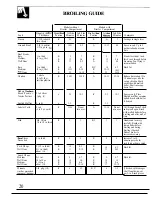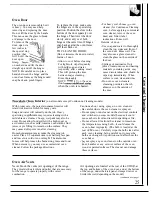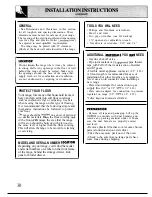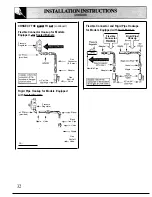
SAFETY INSTRUCTIONS
Instigation
of
range must conform
local codes, or in the absence of local codes,
National Fuel Gas Code, ANSI
latest edition.
Canada,
must conform
current Natural Gas
Code,
or
current Propane
Code,
and
codes
This range has been
by the
American Gas Association according to
ANSI
221.1, latest edition
Canadian Gas Association
according to
latest edition. As with
appliance using gas and generating heat,
there are certain safety precautions you should
follow. You will find these precautions in the
Important Safety Instructions in the front of this
book. Read them carefully.
●
Have your range installed by a
installer or service technician.
●
Your range must be electrically grounded in
accordance with local codes or, in the absence
of local codes, in accordance with the National
Electrical Code
70, latest edition).
In Canada, electrical grounding must be in
accordance with
current
Canadian
Electrical Code Part 1 and/or local codes. See
Electrical Connections in this section.
●
Before installing your range on linoleum or
any other synthetic floor covering, make sure
the floor covering can withstand
without
shrinking, warping or discoloring. Do not install
the range over carpeting unless a sheet of 1/4”
thick plywood or similar insulator is placed
between the range and carpeting.
●
Make sure the wall coverings around the
range
withstand heat generated by the
range up to 200°
●
Avoid placing cabinets above the range. To
reduce the hazard caused by reaching over the
open flames of operating burners, install a
ventilation hood over the range that projects
forward at least 5“ beyond the front of the cabinets.
●
The ventilating hood must be constructed of
sheet metal not less than 0.0122” thick. Install
above the
with a clearance of not less
than 1/4” between the hood and the underside
of the combustible material or metal cabinet.
The hood must beat least as wide as the
appliance and centered over the appliance.
Clearance between the cooking surface and the
ventilation hood surface
INCHES.
. If cabinets are placed above t e
allow a
minimum clearance of 30” between the cooking
surface and the bottom of unprotected cabinets.
●
a
30” clearance between cooking surface
and overhead combustible material or
cabinets
be maintained, protect the
underside of the cabinets above the
with
not less than
insulating
covered
with sheet
not less than 0.0122” thick.
●
Clearance between the cooking surface and
protected cabinets MUST
BE
THAN 24 INCHES. The vertical distance from
the plane of the cooking surface to the bottom of
adjacent overhead cabinets extending closer than
1“ to the plane of the range sides must not be
less
18”. (See Dimensions and Clearances
illustration in this section.)
●
Caution: Items of interest to children should
not be stored in cabinets above a range or on the
backsplash of a range—children climbing on the
range to reach items could be seriously injured.
WARNING
ranges can tip and injury could
result. To prevent accidental tipping
of the range, attach an approved
Anti-Tip device to the wall. (See
Installing the Anti-Tip Device in this
section.) To check if the device is
installed and engaged properly,
carefully tip the range forward. The
Anti-Tip device should engage and prevent the
range from tipping over.
If you pull the range out from the wall for any
reason, make sure the Anti-Tip device is engaged
when you push the range back against the wall.
●
For your safety, never use your range for
warming or heating the room. Your oven and
range top are not designed to heat your kitchen.
Top burners should not be operated without
cookware on the grate. Such abuse could result
in fire and damage to your range and will void
your warranty.
●
Do not store or use combustible materials,
gasoline or other flammable vapors and liquids
in the vicinity of this or any other appliance.
Explosions or fires could result.
●
Do not use oven for a storage area. Items
stored in the oven can ignite.
●
Do not let cooking grease or other flammable
materials accumulate in or near the range.
29
















































